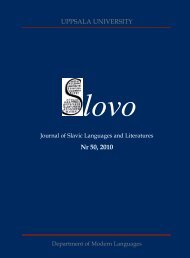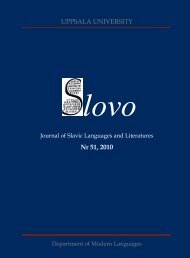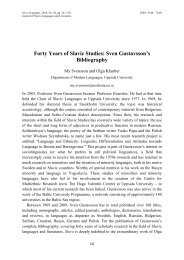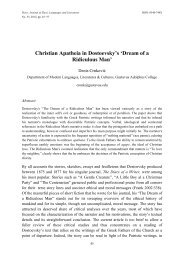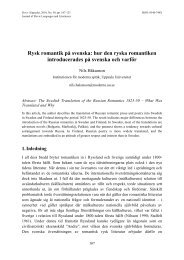Full text PDF - Index of - Uppsala universitet
Full text PDF - Index of - Uppsala universitet
Full text PDF - Index of - Uppsala universitet
You also want an ePaper? Increase the reach of your titles
YUMPU automatically turns print PDFs into web optimized ePapers that Google loves.
Slovo. Journal <strong>of</strong> Slavic Languages and Literatures<br />
No. 52, 2011<br />
notes. In particular, the transcription <strong>of</strong> the first 35 folios is not an easy task because<br />
they are badly damaged. Vakareliyska uses various technical devices in order to<br />
decipher convincingly as much as possible. She transcribes the <strong>text</strong> precisely and<br />
leaves no room for speculation about the illegible letters and signs – her<br />
reconstructions are clearly noted. For the verses which are completely illegible in the<br />
Curzon Gospel, she provides the <strong>text</strong> <strong>of</strong> the 10 th -11 th -century Glagolitic Codex<br />
Zographensis printed in a smaller size, so that the reader can follow the <strong>text</strong> and, at the<br />
same time, be aware that these lines are supplementary.<br />
What is more important and what distinguishes this edition <strong>of</strong> a Middle Bulgarian<br />
manuscript from other similar publications is that the transcription <strong>of</strong> the <strong>text</strong> is<br />
accompanied by numerous variant readings excerpted from thirteen carefully selected<br />
sources. In particular, sources from the (so-called) canonical corpus <strong>of</strong> Old Bulgarian<br />
(Old Church Slavonic) Gospels plus the East Slavonic Ostromir Gospel <strong>of</strong> 1056/7<br />
(which closely renders an Old Bulgarian Vorlage) and seven later Gospel manuscripts<br />
<strong>of</strong> the 12 th -14 th - century: five Middle Bulgarian and two Serbian ones. As a matter <strong>of</strong><br />
fact, in her discussion <strong>of</strong> the <strong>text</strong>ual peculiarities <strong>of</strong> the manuscript chosen for the<br />
edition, Vakareliyska juxtaposes many more sources: 133 Slavonic manuscripts,<br />
mostly Gospels, but also Greek and Latin calendars. The complete list <strong>of</strong> the sources is<br />
given in a well organized appendix where their date, origin, language, orthography,<br />
place in which they are kept, as well as editions (if any) are listed. Many <strong>of</strong> her sources<br />
are manuscripts consulted de visu. This rich apparatus <strong>of</strong> variants allows for wellgrounded<br />
conclusions about the Gospel <strong>text</strong>ual history and linguistic variation in<br />
mediaeval Slavonic culture.<br />
Only on the basis <strong>of</strong> this rich collection <strong>of</strong> comparative material it became possible<br />
for the author to identify the <strong>text</strong>ual family to which the Curzon Gospel belongs and to<br />
elucidate its specifics. At the same time, the large picture <strong>of</strong> variants contributes to the<br />
discussion <strong>of</strong> the general methodological question: how to distinguish intentional<br />
revisions by editors from spontaneous changes by scribes, particularly in the <strong>text</strong>s<br />
which were largely used by the Church, such as the New Testament and Psalter. This<br />
laborious type <strong>of</strong> edition contributes also to the study <strong>of</strong> the interrelations <strong>of</strong> the three<br />
types <strong>of</strong> Gospel manuscripts in the Byzantine and Slavonic traditions: Four Gospels<br />
(Tetraeuangelia), <strong>of</strong>ten accompanied with liturgical instructions, Short Lectionary<br />
Gospels, and <strong>Full</strong> (Long) Lectionary Gospels. Furthermore, the study sheds light on<br />
the variation <strong>of</strong> those Byzantine variant readings, which are not well represented in the<br />
current critical editions <strong>of</strong> the Greek New Testament. The latter aspire to reconstruct<br />
the earliest stage <strong>of</strong> the <strong>text</strong> transmission <strong>of</strong> the Gospel which in many cases differs<br />
from what 9 th -11 th -century Byzantine and medieval Slavonic sources witness.<br />
In Vakareliyska’s book, the transcription <strong>of</strong> the <strong>text</strong> is preceded by an analysis <strong>of</strong><br />
the manuscript’s codicological, palaeographic and some orthographic features. In this<br />
section she also comments on the provenience <strong>of</strong> the Curzon Gospel and on the<br />
98



